6.10.2017
Ariane 6 could use reusable Prometheus engine, designer says
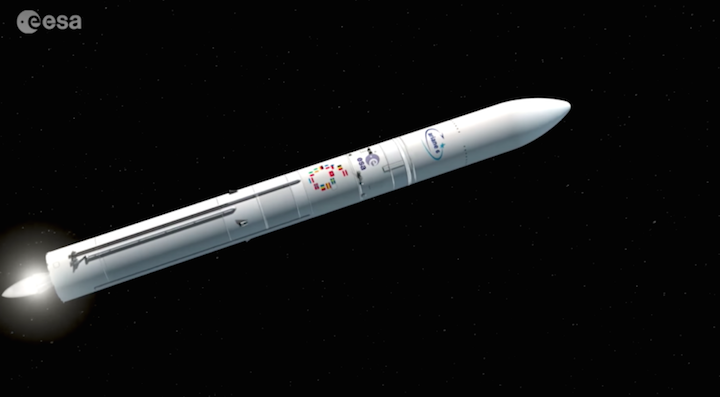
LES MUREAUX, France and WASHINGTON — Europe’s upcoming Ariane 6 rocket, though designed to be expendable, could one day sport a reusable engine, according to Patrick Bonguet, head of the Ariane 6 program at ArianeGroup.
Whether or not the rocket would ever use that engine, called Prometheus, depends on whether Ariane 6 manufacturer ArianeGroup, formerly Airbus Safran Launchers, finds enough benefit for the European launch sector. So far, the merits of reusable rockets to ArianeGroup are unclear at best, Bonguet said, but the company is researching the technology to be ready for implementation should it prove worthwhile.
“We could replace Vulcain 2.1 by Prometheus,” Bonguet told SpaceNews. “Or Prometheus can be the first break to build the next generation. We will see where we are in 2025 or 2030, and then decide on the right time whether to go one way or the other.”
The Ariane 6’s maiden flight is scheduled for 2020, meaning the rocket would fly for at least five years or longer in an expendable configuration with Vulcain 2.1, a streamlined version of the Ariane 5’s Vulcain 2 liquid engine with the same performance.
ArianeGroup’s Prometheus engine received a substantial budget boost this year from the European Space Agency, which is paying the company via a fixed-price contract to build the Ariane 6 as a successor to the Ariane 5. ESA is supplying 85 million euros ($91 million) through its Future Launchers Preparatory Program, and began funding Prometheus in June.
Bonguet said ArianeGroup is studying reusability with Prometheus “in order to be sure to take the right path at the right moment.” Those efforts are mostly to prevent Europe from being caught flat-footed in the wake of other reusable launch systems, namely from SpaceX and now also Blue Origin.
Reusability is far from a primary focus, however.
“We still have not understood, would we save money by reusing? At least with our launch rate?” he asked. “We hope to launch 12 times a year. If we reuse 12 times, that means we only manufacture one time per year. It is difficult for us to have that.”
Bonguet said reusability would essentially erase the production efficiencies ArianeGroup is striving for, starving the Ariane 6 industrial base of the work upon which it relies.
A smaller tip-toe into reusability could come through salvaging Ariane 6’s payload fairings. Swiss manufacturer Ruag Space is developing reusable fairings, which Bonguet said are of interest to ArianeGroup.
“We are discussing with Ruag,” he said. “They have presented to us their concept. If it is working, and if it is bringing cost savings, we will be happy to accommodate it.”
Production value of Ariane 6
ArianeGroup is seeking a 40 percent price reduction for the Ariane 6 compared to the Ariane 5.
The biggest difference between the Ariane 5 and the Ariane 6 is the way the two rockets will be produced, Bonguet said. Compared to the Ariane 5, Europe’s Ariane 6 is factoring in production at the design stage. This includes leveraging an “extended enterprise” concept where ArianeGroup co-designs components with suppliers. Having production efficiency at the forefront of development will allow the rocket to be lower cost yet still reliable, he said.
“Ariane 6 is basically an industrialization of Ariane 5. So, it is not a brand new design. The innovations are more to make it robust to manufacture,” Bonguet said.
ArianeGroup also gains cost savings by leveraging the combined resources of French and German rocketry expertise, which was previously stratified as Airbus and Safran. Bonguet said it is a rational step to further integrate other parts of the Ariane 6 industrial base, but ESA member states would likely reject such integration to prevent losing domestic competencies.
A third means of cost reduction and improved production efficiency is with additive manufacturing, or 3D printing. Bonguet said the Ariane 6 will likely have around a dozen 3D printed parts, compared to just one on the Ariane 5. ArianeGroup is primarily using 3D printing to streamline the production of complicated equipment that is otherwise difficult to machine. The company is also using 3D printing to create an addition to the upper stage called the Auxiliary Power Unit (APU), which is fully 3D printed, he said. The APU is a low-thrust system that enables the Vinci upper stage to drop satellites in multiple orbits for constellation deployment, and can also assist in deorbiting the stage at the end of each mission.
Maintaining schedule
Bonguet said the Ariane 6 is holding to its 2020 schedule, but ArianeGroup had to invest its own non-ESA resources into the test program to hold to that date. He didn’t label the size of the investment, but said ArianeGroup is building an additional upper stage in order to perform tests in parallel with the lower stage.
Bonguet said ArianeGroup will perform tests of the fully integrated Ariane 6 in the second half of 2019 into early 2020. In 2018, test firings will begin for the Avio-supplied strap on solid rocket boosters, he said.
ArianeGroup and Arianespace plan to overlap launches of Ariane 5 and Ariane 6 until around 2023. Bonguet said commercial demand for the Ariane 6 looks promising enough that the company is considering five launches in 2022.
Arianespace bought six more Vega and four Vega C from Avio last month, has yet to place an order for Ariane 6 rockets with ArianeGroup. To keep schedule, ArianeGroup is already buying long-lead items for the first batch.
“We have already ordered long-lead items covering up to launcher 15 already in order to be on time,” he said. “Industry is anticipating the start of production this way. We are doing this because there is an exploitation readiness key point organized by ESA and member states at the end of this year taking place in November-December, with a final outcome in March where the member states will formally endorse Arianespace with the operational role of Ariane 6.”
So far the first Ariane 6 customer is the European Commission for two Galileo launches. Bonguet said ArianeGroup is still waiting on a commitment from the European Commission to aggregate European government demand into a binding commitment for at least five Ariane 6 launches per year. This need, in order to ensure stable demand for the rocket, “is confirmed in principle,” but has yet to be confirmed in a contractual manner, he said.
Quelle: SN
---
Update: 8.04.2018
.
The 1st nozzle of the P120 booster common to Ariane 6 and Vega-C on its way to Kourou
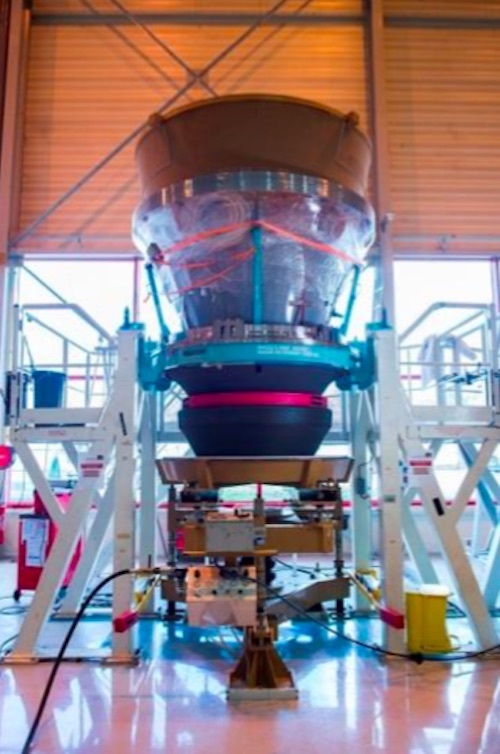
The 1st nozzle of the P120 solid rocket motor manufactured in the ArianeGroup plant in Le Haillan is en route for Kourou
-
The nozzle is an essential sub-assembly which creates thrust by ejecting themotor’s combustion gases
-
This new step confirms the progress made by the Ariane 6 program, which is on-schedule
The first images can be downloaded from XXXX
The first nozzle of the P120 solid rocket motor common to the future European launchers has just left for the Guiana Space Centre in Kourou (French Guiana). It will be fitted to the body of the booster intended for the first firing test on the solid rocket booster test stand (BEAP).
This nozzle, which makes use of the most advanced solid fuel technologies, was designed by the ArianeGroup teams on the Le Haillan site near Bordeaux.
For Yves Traissac, head of solid fuel propulsion at ArianeGroup: “The P120 nozzle is a model of technological success and design to cost. It meets the exacting demands of the Ariane 6 and Vega-C programs. This achievement is the result of the experience acquired by our teams with the Ariane 5 and Vega programs. This new nozzle comprises a number of highly competitive innovations, such as a flexible pivot with composite reinforcements and transfer of elastomers, jet path parts made of a new carbon/carbon material, a composite divergent nozzle with industrial winding and fullyautomated assembly.”
The P120 contains 142 metric tons of solid propellant, its lift-off thrust can reach 400 tons and the motor runs for 130 seconds. The nozzle allows very high speed ejection of the very hot gases (3,000°C) generated by the motor, thus creating thrust by transforming the energy of the combustion gases into kinetic energy. It can also pivot, which enables the launcher to be piloted. The technologies and materials used, including thermostructural(1) composites, are able to dealwith these extreme conditions throughout the motor’s operating period. The nozzle contributes to meeting the goals of the Ariane 6 and Vega-C programs: optimized costs, shorter cycles owing to a simplified design and the use of innovative technologies and processes.
Once assembled, the P120 motor will be tested on the BEAP in Kourou during the summer of 2018. Two other test stand firings will follow to qualify this motor before the flights of Vega-C in 2019 and Ariane 6 in 2020.
(1) Thermostructural: composite materials with excellent mechanical properties at very high temperature.
Design authority and industrial lead contractor for the development and operation of the Ariane 6 launcher on behalf of the European Space Agency (ESA), ArianeGroup coordinates an industrial network of more than 600 companies in 13 European countries, including more than 350 Small and Medium Enterprises (SMEs).
Quelle: ariane.group
---
Update: 1.06.2018
.
Germany trades P120 booster production for Ariane 6 turbo pumps, upper stage carbon fiber research
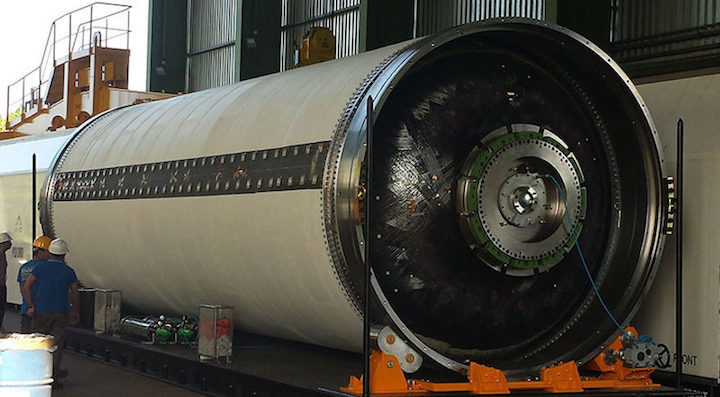
The P120C booster will power the first stage of Vega C and serve as the strap-on booster for Ariane 6. Credit: Avio.
-
WASHINGTON — European Space Agency member states have agreed to keep all production of P120 solid rocket boosters in Italy instead of opening a second production line in Germany.
Germany will instead produce turbo pumps for the upcoming Ariane 6 rocket and redirect its P120 funds towards technology maturation work on a carbon fiber upper stage that could give Ariane 6 another 1,000 kilograms of lift capacity.
The compromise, reached during a May 17-18 meeting of the ESA launcher program board in Frascati, Italy, puts to rest the controversial division of P120 production. The 2016 decision, while popular in Germany, was viewed unfavorably in Italy.
The P120 serves as the first stage of the Vega C rocket and will be used as a strap-on booster for the Ariane 6 heavy-lift rocket. Vega C, like the standard Vega rocket used today, is built almost entirely in Italy. Ariane 6 production, in contrast, is spread more broadly across France, Germany and other ESA member states who pay for the launcher’s development and use.
“The production of the P120 will be done in its full capacity in Italy,” Daniel Neuenschwander, ESA’s director of space transportation, told SpaceNews May 24. In addition, some 70 million euros ($80.8 million) in German funds originally slated for the second production line are being repurposed for a potential carbon fiber upgrade to the Ariane 6 upper stage. ArianeGroup CEO Alain Charmeau, said the upgrade, still under consideration for implementation, wouldn’t be incorporated until at least 2025 — five years after Ariane 6’s scheduled maiden flight.
The German division of Ariane 6 prime contractor ArianeGroup will build the turbo pumps previously supplied by Vega C prime contractor Avio, Neuenschwander said. Avio declined to comment on the transfer of production responsibilities.
MT Aerospace, a subsidiary of German space company OHB, was preparing to run the second P120 manufacturing line in 2021 or 2022 using a carbon fiber production method it said was more cost-effective than Avio’s technique. Neuenschwander confirmed the 70 million euros will go toward validating “technology prework which has been done on carbon fiber activities” by German industry.
Charmeau told SpaceNews his company is working with MT Aerospace on implementing carbon fiber cryogenic tanks and other structures for the Ariane 6 upper stage. Redesigning metallic structures with carbon fiber would result in a lighter stage, enabling the rocket to carry heavier payloads to orbit, he said.
“We target at least a one-ton performance increase,” he said. The improved upper stage would have its first flight between 2025 and 2030, depending on budget provisions from ESA, he said.
“One kilogram saved on the inner structure of the upper stage is a direct additional kilogram for the payload, one to one, so by using carbon fiber structures we will reduce the weight of the upper stage and therefore increase the capability for the payload,” he said.
The upper stage upgrade would increase maximum Ariane 6’s lift capacity to 13,000 kilograms, roughly 12 percent more than the heaviest Ariane 5 launch performed to date.
Quelle: SN
---
Update: 17.06.2018
.
14 June 2018
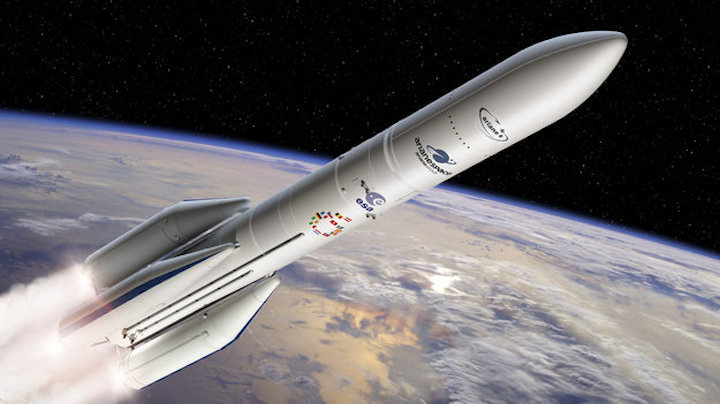
The ESA Council met today in Paris to discuss the path towards the future exploitation of Ariane 6.
In view of the progress made in the Ariane 6 programme, Participating States have decided on the completion of the development up to full operational capability and agreed to fund industrial incentives associated with the development of Ariane 6 and P120C solid rocket motor.
Participating States also committed to start with the first step of the Ariane 6 and P120C Transition Programme. This programme supports the evolution from Europe’s Ariane 5 to full operational capability of Ariane 6.
Ariane 6 is Europe’s new-generation launcher, designed to secure guaranteed access to space for Europe at an affordable price for European institutional users. It will operate in two configurations: Ariane 62 is fitted with two P120C strap-on boosters while Ariane 64 has four. Ariane 6’s maiden flight is planned for mid-2020.
P120C is the largest carbon-fibre solid propellant booster ever built in one segment at almost 13.5 m long and about 3.4 m in diameter. Two boosters will be used on Ariane 6’s maiden flight in 2020.
Quelle: ESA
---
Update: 17.08.2018
.
Ariane 6 is nearing completion, but Europe’s work is far from over
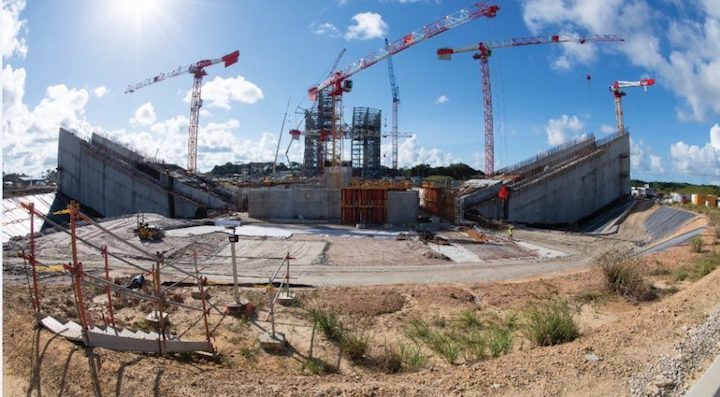
The French space agency CNES is funding construction of the Ariane 6 launch pad at the European spaceport in Kourou, French Guiana. Credit: ESA
-
In 2014, when the European Space Agency settled on a six-year roadmap for the development of two next-generation rockets — Ariane 6 and Vega C — Europe’s main launch service provider Arianespace was still in the driver’s seat.
International Launch Services was recovering from another Proton failure. Sea Launch was in drydock. SpaceX had just begun to crack the commercial market.
The competitive landscape was shifting but Arianespace still sat firmly on top with its Ariane 5, Soyuz and Vega rockets.
Responding to the threat SpaceX’s lowpriced Falcon 9 posed to Europe’s launch sector dominance, ESA and its industrial partners ArianeGroup and Avio made cost control a defining requirement of Europe’s future launch vehicles.
In the intervening four years, SpaceX has cemented its presence. Falcon 9 has performed more than 55 launches for civil, military and commercial customers to date, including nearly a dozen missions where the rocket’s nine-engine first stage made a second trip to space.
In 2017 SpaceX won six internationally competed commercial launch contracts, closing in on Arianespace, which won nine, according to Bryce Space and Technology data.
Arianespace’s competitive landscape isn’t getting any easier. In the U.S., Blue Origin and United Launch Alliance are developing Ariane 6 competitors, Russia is building Angara, India is gaining traction with GSLV, Japan is building the H3 and China is aiming its Long March family at markets further beyond its borders.
In the midst of these changes, ESA is pushing European industry to continue innovating and finding efficiencies even after Vega C’s introduction in 2019 and Ariane 6’s debut in 2020.
“I am convinced personally that it must be a permanent endeavor of industry to think about cost reduction leading to competitiveness increases,” Daniel Neuenschwander, ESA’s director of Space Transportation, said in an interview.

Neuenschwander intends to bring multiple proposals to ESA’s next ministerial council, scheduled for the end of 2019, to reinforce the cost-reduction mindset.
One of Neuenschwander’s proposals will relate to making the Ariane 6 and Vega C upper stages more cost competitive. Another, he said, is about reusability.
“We are looking at cost reduction in all dimensions … cost reduction through reusability is also a focus area for me to be brought to the next ministerial,” he said.
New goals
Europe aims to sell Ariane 6 rockets for about half of the $178 million Bryce Space and Technology says Arianespace charges for Ariane 5 missions.
It expects to achieve these savings by aggressively reducing production costs among the network of industrial suppliers that build the launch vehicle. For starters, Europe will produce a common solid rocket booster — the P120 — for Vega C’s first stage and Ariane 6’s strap-on boosters, lowering costs through greater production volume.
ArianeGroup is being judicious in its insertion of new technology. Ariane 6 will use an upgraded version of Ariane 5’s Vulcain 2 main engine and a Vinci upper-stage engine more than 15 years in development. Two Ariane 6 variants — the Ariane 62 with two strap-on boosters and the more powerful Ariane 64 with four strap-ons — will give the new workhorse a wider performance envelope than the current Ariane 5.
Ariane 6 can carry 10,000 to nearly 22,000 kilograms to low Earth orbit (LEO) and 5,000 to 11,500 kilograms to geostationary transfer orbit (GTO).
Ariane 5 can carry 20,000 kilograms to LEO and 11,115 kilograms to GTO.
ArianeGroup, the prime contractor for Ariane 6, has described the next-generation rocket as “basically an industrialization of Ariane 5.”
In a telling statement, Arianespace CEO Stéphane Isräel described the looming introduction of Vega C and Ariane 6 as a starting, not an ending.
“We are at the beginning of a new journey,” Isräel said June 27 during a press briefing at ConnecTechAsia in Singapore. “This journey is a journey where the European launcher sector is going to innovate more and quicker.”
That sentiment isn’t limited to Isräel and other officials responsible for keeping European launchers competitive for the long haul.
“The Ariane 6 is not going to come out as a final product, not in the sense that it won’t be mature or reliable, but there is nothing earth-shattering in it,” said Michele Franci, the former chief technology officer of Inmarsat who left last year to do independent consulting for the satellite and launch industries. “There are other developments ongoing in parallel in Europe, so by the time Ariane 6 is operational, these developments should become mature and it will be time to introduce them.”
Franci, who had direct responsibility for launch contracts at Inmarsat and had previous careers at SES and Arianespace, said what’s going on now is for “the first time ever a conscious effort to design to cost and design to efficiency.”
“But it’s not done,” he adds.
Alain Charmeau, CEO of ArianeGroup, said the company has three major projects underway for future evolutions of the Ariane 6.

“One is Prometheus, a new LOX-methane engine that is definitely low cost — 10 times less costly to produce than the current Vulcain 2 engine — with potential reusability,” he said. “The second is to work on technologies for reusability of the main stage of Ariane 6, and the third one is to work on an upgrade of the upper stage by using carbon-fiber structures instead of metallic structures as is the case today.”
Each of those projects is already under development in parallel with Ariane 6. ESA awarded ArianeGroup 75 million euros ($85 million) in December to begin production of the first two Prometheus engines. Charmeau said ArianeGroup is working with German partner MT Aerospace on cryogenic tanks and on the structure of the carbon-fiber upper stage. Depending on ESA backing, the improved upper stage could add one metric ton to Ariane 6’s lift performance between 2025 and 2030, according to Charmeau.
Regarding the improved upper stage, Arianespace has “the ambition to fly it on Ariane 6 as quick as possible,” Isräel said.
“We could target to have an evolution of Ariane 6 in 2025,” he said. “It is not decided yet, but it is something we could achieve and we could have here the building blocks of these evolutions.”
Where reusability will fit in is to be determined.
The SpaceX effect
ONERA, a aerospace-focused French defense research group similar to the Pentagon’s Defense Advanced Research Projects Agency in the U.S., is working with the French space agency CNES and ArianeGroup to figure out how reusability can be achieved in Europe.
“At the beginning the question with reusability was is it feasible?” recalled Gérard Ordonneau, the director of launch programs ONERA’s space division. “SpaceX showed that it is feasible to land a stage and reuse it.”
Ordonneau said ONERA is working with CNES on Callisto, a small rocket designed to practice Falcon 9-style vertical recovery — what in Europe is called a “toss back” — that “could lead to an evolution of Ariane 6.”
“Ariane 6 has a design to answer the question of cost reduction without reusability because the development of reusability needs some time,” he said.
Callisto is expected to launch in 2020, but will be too small to fly the reusable Prometheus engine that comes out the same year.
ONERA doesn’t produce components, but identifies ways to improve engine design. Ordonneau said ONERA has an unpaid cooperation pact with ArianeGroup to help them increase confidence in the performance margins of Prometheus and any variants of the engine.
The burning question of reusability
Europe has studied reusable rockets for decades, including “fly-back” versions of the Ariane 5 with winged boosters for runway landings, but never concluded it was worthwhile to implement. The success of SpaceX has supplied the impetus to study reusability with renewed vigor.
“There is an acceleration of innovation,” said Ordonneau. “We need to work on reusability in different ways — in toss-back and in fly-back. There are other configurations studied by CNES with the help of ONERA and [the German space agency] DLR. The design of this configuration needs to be evaluated in terms of cost, number of reuse and so on.”
Central to the reusability debate is whether any rocket can launch at a high enough rate to justify the investment. European officials have bemoaned the willingness of some ESA members, like Luxembourg with GovSat-1, to launch their satellites overseas on non-European rockets.
Opinions differ on just how critical reusability will be for Ariane rockets. Teal Group analyst Marco Caceres’ view is the one keeping European workers and policymakers up at night.
“To simply say going for reusability doesn’t make any sense is fine, but then you are going to be eliminated from this industry in a few years,” Caceres said.
SpaceX’s launch costs, already undercutting the entire industry, will have room to drop even lower as the company routinizes reuse of the Falcon 9 and Falcon Heavy rockets, Caceres said.
“Traditionally, launch companies, particularly those run by governments or that have stock holders concerned about their price… are more conservative,” he said. “They play defense … this is now a different game, and it’s one they don’t know how to play very well yet. If they don’t play it, then they are going to lose out.”
Franci dismissed that logic. “I think Ariane 6 vehicle is more competitive than it looks,” he said. Franci declined to state Ariane 6 prices quoted to him while at Inmarsat, but said the difference between those and the Ariane 5 are substantial.
“The improvements are really there. They are important and they are material. If you look at the Ariane 5 and the Ariane 6, the product competitiveness in pricing terms is very significant,” he said.
Franci admitted SpaceX’s success has forced ArianeGroup’s sales and marketing division Arianespace to sell Ariane 5 at “very aggressive prices” — so much so that current prices are already eroding the anticipated 50 percent price drop with Ariane 6, he said. The rocket will still open a new chapter for Europe as an expendable vehicle, but that’s no excuse for resting on laurels, he warned.
“Reusability may or may not be an effective idea,” he said. “But it should be looked at in earnest.”
Quelle: SN

